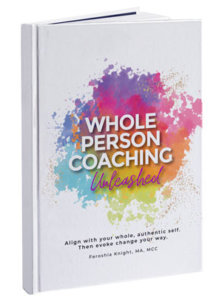Having an expanded perspective leads to a more open mindset. It is one of the key tools that enables us to see what’s missing, both in specific moments and our lives as a whole!
Neuroscience teaches that you can create a more complete picture when you expand what you are “sensing.” It’s a practice that leads to additional and often more accurate information. This ultimately produces greater understanding.
Yet we are often caught in either a left-hemispheric perspective of getting stuck in the details or a right-hemispheric lens whereas we feel overwhelmed and chaotic lost in the big picture.
Stuck down into the details…
If someone is viewing themselves or a given situation from a more left-hemispheric perspective, it’s likely they will be more rigidly focused on something minute and miss out on additional details. That is how they are looking at what they are doing is so focused, that they stop being able to see how it all fits into the bigger picture, the end result they are seeking to create.
For example, in my marketing clients they find themselves lost in learning technology, vs seeing where their strengths lie from a more holistic point of view. After spending countless hours stuck in the details, they realize with a broader perspective that maybe it is worth investing in some tech help. Instead of doing it all, being at the helm of their business.
When we have more information, we can see the holes in our thinking – our blind spots. Without more perspective, our decisions and reactions don’t always pair with our reality accurately.
Stress is a huge factor…
For example, if you are prone to a lot of stress, your brain may naturally default to a more rigid or left-hemispheric reaction.
You might recognize this when you find yourself craving a checklist, a plan, a personal landing strip, or environmental conditions that help you feel in control. I’ve known people who have perfectly organized closets, with clothes that are grouped not just by season but also by color. It gives them peace of mind, no pun intended.
Yet, when this level of detail and organization leaves someone unable to move the needle on their desired changes, it’s time to contextualize their situation from a right-hemispheric perspective. That is the bigger picture.
As a Whole Person Coach, you invite your clients into a meaning-making process. Connecting them with the what and the why underneath the what they are doing in the moment. Shifting them from the details and enabling them to see the bigger picture. When someone is able to connect to the importance of what they are doing, they become motivated to shift into change. They can more easily let go of the analysis paralysis or over perfection that can occur.
Right-hemispheric folks often feel bored, constrained, and even stressed by too much planning or order. Because they can get overwhelmed holding onto the big picture, people who are in a right-hemispheric perspective can feel very chaotic and overloaded.
Working with these clients who are naturals in the big picture perspective, it can be helpful to first help them relax.
This might invite their mind to wander. Or to consider ways in which they could find solitude such as in nature and other wide open spaces. I’ve often found that walking my dogs and enjoying how they experience their world, largely through smell, unwinds my mind so I can rethink through my challenges and executive on my opportunities.
As a Whole Person Coach, you work with the whole of who your clients are.
From a Whole-Brain approach this means helping your client to balance the use of their whole brain and to recognize what kind of thinking mode or perspective they are operating from.
Through questions, reflections and even with silence you can help people to truly know themselves and how they function best.
And this helps them to be unstoppable in achieving their goals, and you the instrument of change that helped them to do so!



